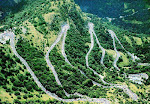This image from last weekend's Milano-Sanremo caused a bit of flutter on Twitter, as fans such as @Plastic_Peloton adopted the role of the young boy in the Emperor's New Clothes to point out how ridiculously poor Fabian Wegmann's choice of clothing for the wet and cold race made him look. Functionally perfect garb perhaps, but surely no-one can dispute that sartorially this represents a backward step. A big one too.
For me it's even more fundamental than simply kit that just looks naff: at first hand more large corporations coming into cycling, investing large sums of money in teams in order to market their products to an increasingly large audience might seem like a positive development. However, more insidious in my mind is the increasing human disconnect we're witnessing in our sport brought by this shift, where once-accessible riders are increasingly isolated from their public - either by ill-advised egotistical behaviour fitting of superstar pop divas, privacy windows on Tour buses, burley minders keeping fans at arms' length - or through 'technical' accessories that disguise them completely like these. So many of the Milano-Sanremo riders out there that day were barely recognisable: is this anonymity the price we're paying for supposed progress?
 |
| Oh dear. |
Admittedly the peloton was well wrapped-up against the elements for La Primavera, but this trend - more sponsors products like glasses and helmets contractually foisted on the riders, identikit jerseys à la Rapha and bland, black plastic 'stealth' bicycles - means riders are virtually indistinguishable one from the other. Riders increasingly resemble corporate billboards, employees rather than riders, reduced to anonymous Robocop automata in a cycling video game rather than individuals with their own style, characters and visual reference points. Interviews too, are, for the most part, simply distilled down to PR opportunities where riders must not stray one iota from sponsors' messaging. In the same way Formula One lost its mojo, cycling risks becoming souless ... thank goodness when Brit-pop bad-boys Cav and Wiggo go off script.
Compare and contrast the above with this image taken during the 1984 Tour de France. Now I've been a fan of the bike for longer than the 30 years since this picture was taken (and I know that the eagle-eyed amongst you will know just from glimpsing Laurent Fignon's Super Record front brake calliper arm being on the 'wrong' side that the image is flopped), but I can still name them all without too much trouble. Next season, 1985, the big money arrived: Bernard Tapie lured Greg from Renault for a million-dollar contract, the American started sporting Oakley Factory Pilots, and arguably this started the downward spiral, as cycling became more commercially confident and moved on from its almost quaint, parochial European roots.
 |
| Name them. Not too hard, is it? |
 |
| Name them. Bit of a challenge, eh? Cyclists? They all look the same to me. |
And finally, if you want to argue that I've been disingenuous by picking a Tour de France summer pic from the past, with riders in short sleeves in the optimum riding conditions rather than the rain and mist of Milano-Sanremo, have a look at the image above and tell me how many of the riders you can name. Yeah, there's some guys from Orica-Greenedge and Garmin-Sharp, on their black Scott and Cervélo bikes for sure, but who are they? And will you be able to name them in 30 years' time?










